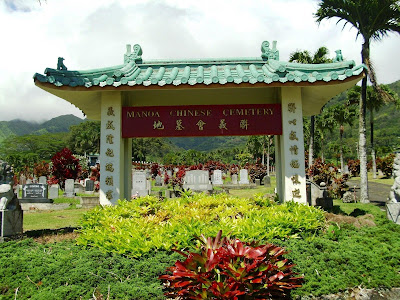Detective Chang Apana was really Hawaii's first action hero. He once arrested forty suspects all by himself in Chinatown, with no backup at all. That is an accomplishment that has never been equaled in the historical records of the Honolulu Police Department. Here are some of Chang Apana's exploits as described in my forthcoming book "Charlie Chan's Hawaii":
"Fred Kramer, retired Captain of the Guards at Oahu Prison and Halawa Jail, had some interesting reminiscences about Detective Chang Apana. Kramer actually saw Apana in action leaping from roof to roof in Chinatown, like a human fly. In appearance, Kramer recalls, 'Apana looked so frail that one slap could break him apart.' "
"Apana, though fragile in appearance, was in reality a very tough man. Once while attempting to raid a gambling game, he was hurled from a second story window, but like the proverbial cat, he landed miraculously, on his feet unhurt. Another time when arresting a dangerous Filipino suspect, he was slashed across the stomach with a knife. Again he emerged unscathed as the knife landed on a broad belt that he was wearing."
"Apana had another close brush with death during the arrest of a prison escapee. He was assigned with Chief of Detectives Arthur McDuffie, and Assistant Chief John Kellett to capture a Korean, who had broken out of jail, and who was known to be a desperate character when cornered.
They finally located their quarry, hiding under a house. When he was ordered to come out the suspect replied with a fusillade of shots, one of the shots boring the palm of Kellett's hand. More shots followed that narrowly missed hitting McDuffie and Apana. In a lull between the shots being exchanged between the escaped felon and the officers, Apana sneaked around the end of the house, while the other two officers held the fugitive at bay. In the twinkling of an eye, Apana pounced on the escaped prisoner. He was in the midst of life and death struggle when the other two officers came to his rescue. At the end of this ordeal, Apana was in such bad shape, that he had to be taken to the hospital for a week to recuperate."
"Fred Kramer, retired Captain of the Guards at Oahu Prison and Halawa Jail, had some interesting reminiscences about Detective Chang Apana. Kramer actually saw Apana in action leaping from roof to roof in Chinatown, like a human fly. In appearance, Kramer recalls, 'Apana looked so frail that one slap could break him apart.' "
"Apana, though fragile in appearance, was in reality a very tough man. Once while attempting to raid a gambling game, he was hurled from a second story window, but like the proverbial cat, he landed miraculously, on his feet unhurt. Another time when arresting a dangerous Filipino suspect, he was slashed across the stomach with a knife. Again he emerged unscathed as the knife landed on a broad belt that he was wearing."
"Apana had another close brush with death during the arrest of a prison escapee. He was assigned with Chief of Detectives Arthur McDuffie, and Assistant Chief John Kellett to capture a Korean, who had broken out of jail, and who was known to be a desperate character when cornered.
They finally located their quarry, hiding under a house. When he was ordered to come out the suspect replied with a fusillade of shots, one of the shots boring the palm of Kellett's hand. More shots followed that narrowly missed hitting McDuffie and Apana. In a lull between the shots being exchanged between the escaped felon and the officers, Apana sneaked around the end of the house, while the other two officers held the fugitive at bay. In the twinkling of an eye, Apana pounced on the escaped prisoner. He was in the midst of life and death struggle when the other two officers came to his rescue. At the end of this ordeal, Apana was in such bad shape, that he had to be taken to the hospital for a week to recuperate."
Please click on video widget below to watch "The Legend Of Chang Apana" that was produced by Jon Brekke, for Oceanic Creative Services. It is the pilot for a projected TV series that hopefully will be in production soon. Unfortunately, though, they got Detective Chang Apana's badge number wrong. It's supposed to be badge number 100, not badge number 352. When the series finally gets going they should have technical advisers on hand to catch mistakes of this kind. The creators of "The Legend Of Chang Apana", have put together incredible graphics, along with a script that has a smooth contemporary feel to it, to tell the exciting story of Detective Chang Apana. It stars Cary Hiroyuki Tagawa as Chang Apana. This movie is hip, slick, intelligent, and very now! My congratulations go out to the makers of "The Legend Of Chang Apana", for doing such an outstanding job!















